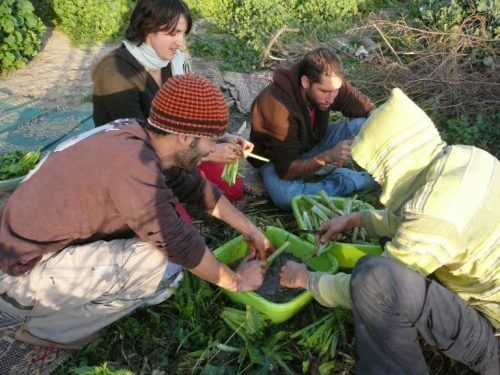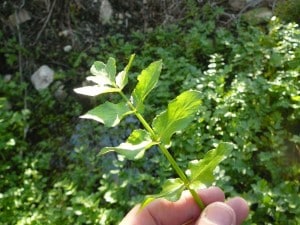If you see people on the edge of fields and roads with their eyes fixed on the ground, it is not certain that they are looking for Pokemon - they may just be gathering their next meal. And there is also a recipe
Shahar Shlouch, Angle - news agency for science and the environment
Topping off your lunch with a chilled Sabers shake from the fruit you picked up in the morning. Get excited when the girl recognizes watercress leaves herself and add them to the sandwiches you took with you on the trip. Pick a ripe fig that smiles at you from a tree by the side of the road. Summer gives these small gestures to those who don't shy away from going for a walk and gathering in the hot season.
"Gathering food is a tradition that originates from the reality of a life of poverty and deprivation," says Dr. Nof Atamana Esmail, who previously won the Master Chef cooking program. "It was common in the rural areas. The villagers, although most of them grew food, still needed the free food provided by nature. On the other hand, in the cities, whose residents enjoyed an improved socio-economic situation, the gathering culture was not as developed as in the villages (and not necessarily because of the lack of nearby forest areas, because in Jaffa about a hundred years ago, the forest areas were available). Since collecting was seen as a practice of the poor, many stopped going out to collect for fear of harming their image. Another reason for the disappearance of this tradition is the departure of women, who were the main breadwinners, into the labor market. As a result of this, they have no time left to collect."
Gathering food in the wild, which used to be of survival importance, has become in recent years mainly a leisure activity. The supermarkets and food stores provide washed and packaged vegetables and fruits throughout the year and at the same time the open areas where you can collect wild plants for food and medicine are getting smaller and smaller. Talor Cohen, a science teacher with an emphasis on sustainability and a picking instructor, says that there is an increase in the popularity of picking and attributes it to the greater availability of instructors in the field and the spread of veganism. "Many of the family members who come to the vegan picking tours and other families are simply interested in going out into nature with added value," she says.

What are collected?
There are two main categories of collection plants. The first is heritage plants, shrubs and fruit trees left in abandoned settlements: pomegranate, fig, vines and saber. The second category is wild plants: the snipe, whose flower buds and fruits, called avionites, can be harvested and eaten; Yarboz in its various species and gooseberry, both relatives of the quinoa, whose leaves can be eaten; Fenugreek, whose flowers can be eaten this season and tea made from the seeds; mustard seeds for seasoning and making a spread; seeds of nettle balls that can be used as a salad addition; Carobs, Regela (the garden leg) whose leaves can be eaten raw or cooked; And Eretz Yisraeli blackthorn and wide-leaved blackthorn, the ones with the sweet fruits.
Throughout the year you can collect aquatic plants. So, for example, you can cook and eat the starchy root of the end (be careful not to uproot the whole plant, but only its shoots) and eat its pollen, which is a good source of protein that can be added to doughs. In humid areas, watercress and marsh cress grow, both from the cruciferous family and have delicious leaves for salad. In the summer you can also collect spice plants (most of the spice plants are on the list of protected plants, except for white zota and tanner's cake).
Are there free meals?
Those who make picking a routine can save money and earn organic food for free. In Cohen's kitchen, for example, there is a constant presence of collected loot, even in the summer. The nettle seeds go into salads, porridges and crackers. The sable fruit is eaten as it is or goes into ice creams and smoothies. The saber stalks (the fleshy green "paws" that are sometimes called leaves) can be eaten raw, boiled or roasted, in a salad or as an antipasti. Cohen notes that they are more nutritious before the fruits ripen. She makes spreads or grinds the mustard seeds and uses them for seasoning. The sweet fennel flowers go into the salad.
Shimi Raf, a veteran picker who is involved in the training of picker guides, says that for him the pickerel makes up 20-5 percent of the menu. "All wild plants are very rich in nutrients and even a small amount can make a big difference in our health. They have a greater nutritional density than fruits," he says.
Where should you collect?
There is something to pick even within the city (even if you refrain from picking fruit from the neighbors' yards). Thus, for example, ficus esdrat and sycamore trees, both of the fig and mulberry family, provide edible fruit in the summer. "There are ornamental plants that not everyone is aware of their edible potential: large collapse, a spiky ornamental plant with juicy red fruits; Fruits of an ornamental coconut palm, where you can eat the orange outer shell of its fruits and the kernel, which is actually a small coconut; You can also eat the pitango, which grows in the cities as an ornamental plant," says Raf.

However, picking herbs in the city will be more challenging. "Most municipalities take down dry plants in the summer for fear of fires," explains Cohen. "If you collect in the city, then mainly on the outskirts of the settlement." Inside the city you can also collect near community gardens, where there is unsprayed grass. On the sides of roads, on the other hand, it is not recommended to collect, for two reasons: the exposure to pollution and the tendency of local and national authorities to spray the vegetation there with herbicides. It should be noted that the effects of the spray on the plant are not always visible to the eye immediately after application, but plants with color disturbances, suddenly withered surfaces and the absence of insects are important warning signs of sprayed plants. In addition, some municipalities place signs near non-sprayed gardens.
"I gather at the edges of fields, but I recommend avoiding gathering in areas of crops that receive intensive pest control such as orchards, cotton and sunflowers," says Cohen. Safer agricultural areas are avocado groves and patches of watermelons, pumpkins and melons.
When do you go out to collect?
Most of the picking trips are concentrated in the cold season, "mainly because in the winter there are a lot of green plants that can be picked, because this is the season when all the annuals grow", as Cohen explains. "But even in the summer there is a lot to collect, if you know what to look for - if in the winter we focus on the leaves, for example, then in the summer we will actually look for seeds, which have a large mass of energy."
The best way to enjoy picking in the summer is to go out early in the morning, before the hot hours, or in the afternoon, to pick the food. Then you can return home (or to the tent) with ingredients for breakfast or dinner.
Not every collecting trip has to be defined as such. If you're out anyway, camping, picnicking, or on a trip, you can just go for a short picking round. If you want to escape the sun for a bit, you can, for example, walk around in the shade of trees and find plenty of edible pine nuts - "not only of the pine pine, but also of the Jerusalem pine, both of which are very common in the forests of Israel," mentions Raf, who also points out that before going out to pick, you should have a guide plants and remember the most important rule in collecting: what you don't know, don't collect and certainly don't eat.
Be part of nature
Collecting is more than an opportunity to spend time in nature. It can be an enriching, educational and combined activity in outdoor bone extraction for children and adults. Those who collect several times throughout the year can experience all the subtleties of the change of seasons, and those who collect regularly can notice changes of a larger magnitude in rainfall patterns, frequency of droughts and changes in vegetation. Collecting, therefore, is a way not only to visit nature but also to be a part of it.
"Gathering is a valuable tool for survival," concludes Ismail, "and just as I absorbed the knowledge from my mother and grandmother, so I also insist on going out with my children and teaching them to collect."
Talor Cohen's recipe for a summer salad
Ingredients: mustard seeds, saber fruits, figs, rigella, salt, olive oil and wine vinegar.
Method of preparation: chop the harigla, tear the figs or cut them into quarters, cut the saber fruits into circles or cubes.
Mix everything in a large bowl.
Crush the mustard seeds with a mortar and pestle or a spice grinder.
Preparation of the sauce: mix mustard seed powder, olive oil salt and wine vinegar to taste.
Pour over the salad.
enjoy your meal.

2 תגובות
Thanks!
In the north, Dr. Uri Chizik makes great tours. (not his relative 🙂 )